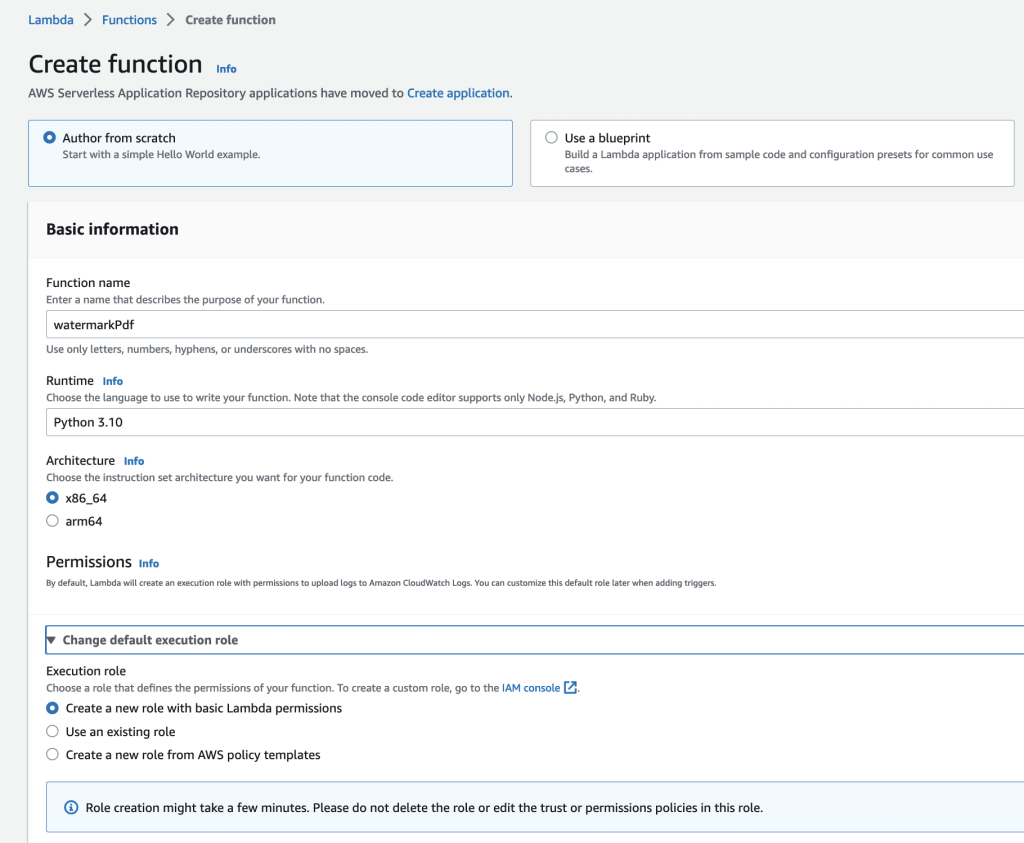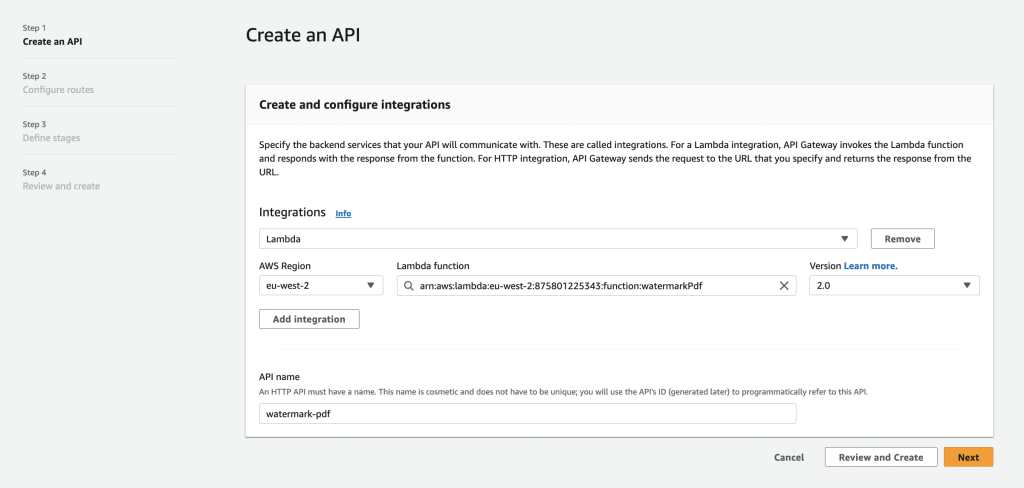Contents:
- Introduction & Goal
- Why Use Lambda anyways?
- Two Real Life Lambda Use Cases
- Local Development Environment (AWS SAM CLI)
- Python Function — Watermarking a PDF
- Local Testing
- Uploading Code to Lambda
- AWS API Gateway — Setting the Endpoint
What’s not covered:
- Authentication/IAM/Roles
- S3/Other services integration
Introduction & Goal
Serverless architecture has some good use but only if you plan for it. Anytime you use a service like AWS Lambda you should ask yourself “Why bother, is the additional complexity really justified?”.
Additionally, you should think about the costs as they can be unpredictable, they’re not constant like EC2 or RDS. I suggest you find out roughly how many requests you’ll be making monthly, each request’s duration on average (Start to finish), how much memory each request needs etc.. Then head over to AWS price calculator and get a prediction.
Last but not least we’ll be using AWS SAM CLI for local development but it’s not a requirement! You can write Python code in lambda_function.py, open API endpoint via Python HTTP server, use Postman to POST to the API, have dependencies installed in same folder, zip it all and upload to S3.
Goal
We’d like to take a PDF to be watermarked, an additional PDF containing a watermark itself and send them both over to AWS and have a new watermarked PDF returned. That’s 2 PDFs sent at once.
Final PDF:

Why Use Lambda anyways?
Generally speaking if you’re not sure about the amount of resource your code will use you can give Lambda a go. It will create temporary server for you and kill it as soon as the request terminates. If you need it to handle more than one request simultaneously it can do so, automatically! It can also increase the server capacity for you should your code need more room.
Two Real Life Lambda Use Cases
Here’s two separate situations where Lambda can be used:
- Process audio files: You can watermark an audio file, cut it, join audios together etc.. if you did this on your EC2 or other server there’s a chance your server would run out of memory etc..
- Extract data from XML files: You can extract data from large XML files. On a regular server you’d need to split the file, Queue it and then extract data off it. With Lambda can upload the file to S3 and process it without having to worry about server bottleneck.
Local Development Environment (AWS SAM CLI)
Go grab and install AWS SAM CLI tool. This is not required but it’ll make out lives easier as it’ll create a basic template/code to work on, setup local API to throw test data at.
You’ll also need to have Docker installed & running as it’s used to create a virtual environment that matches AWS’s environment. This is not a requirement to create Lambda function as I’ve already mentioned.
We’ll follow the basic flow Create Lambda Function Locally -> Test it -> Upload Code to AWS Lambda.
Run sam init to start creating basic project. See the choices I’ve entered in the screenshot below.

That’s it! we got the basic project setup now.
Important note! You’ll need to have experience with whichever runtime you’re using. In this case we’re using Python, NodeJS is another popular option.
Python Function — Watermarking a PDF
Open the hello_world directory and put below code in app.py. Remove the default code first.
import json
import base64
from io import BytesIO
from pypdf import PdfReader
from pypdf import PdfWriter
def lambda_handler(event, context):
# Read and decode Base64 body = json.loads(event['body'])
orig_pdf_base64 = base64.b64decode(body['file'])
watermark_pdf_base64 = base64.b64decode(body['watermark']) orig_pdf = PdfReader(BytesIO(orig_pdf_base64)).pages
new_prd_writer = PdfWriter() # Loop through pages
for page in orig_pdf:
watermark_pdf = PdfReader(BytesIO(watermark_pdf_base64))
watermark_img = watermark_pdf.pages[0]
watermark_img.merge_page(page)
new_prd_writer.add_page(watermark_img) pdf_bytes = BytesIO()
new_prd_writer.write(pdf_bytes)
pdf_bytes.seek(0) # Convert back to base64 and return obj
encoded = base64.b64encode(pdf_bytes.getvalue()).decode('utf-8') return {
"statusCode": 200,
"body": json.dumps({
"message": encoded,
}),
}
Next add dependencies to requirements.txt file withing same folder, add pypdf
Next run sam build from project root (watermark-pdf). This command will build the code & install the dependencies for you. You should run it whenever you make a change. You can also see the dependencies in watermark-pdf/deps.
sam build

Dependencies

Be aware that some of your PDFs may be very large in size! (This may be a good case to use S3 bucket for storage of PDFs but that’s out of the scope of this article). Something to keep in mind.
So far we’ve created a basic project using SAM CLI, installed dependencies and built our code.
Now we’re ready to test it.
Local Testing
Lets start a local API server using SAM CLI and send some data to it to see what Lambda returns..
Before we start the API we have to configure the HTTP method in the template.yaml file. Change the method from get to POST.

Run sam build followed sam local start-api
(Make sure Docker is running..)
The API should have now started.. (note the endpoint, mine is http://127.0.0.1:3000/hello)

Worth keeping in mind that this is just one of many ways to test your code. After all it’s just a Python function!
Sending JSON to the API
The local API is now running this means we’re ready to send JSON data to it via Postman (or any other tool you prefer).
Example JSON format:
{
"file": "base64encoded pdf",
"watermark": "base64encoded watermark pdf"
}
You can use online services to convert the PDFs into Base64 for sake of this tutorial. Be sure to replace the values. Encode both files one by one.
Once they’re both encoded add them both to JSON in Postman and enter the correct endpoint and change the method to POST.

After you’ve entered correct JSON and selected correct settings on Postman hit Send!
The response returned should also be Base64 encoded PDF.
We’ve now confirmed that our Lambda function is working on our local machine. Now lets package our code and upload it to AWS Lambda.
Important note: When data is POST’d via tools like Postman, it shows up within ‘body’ property of JSON, then within that you see the your JSON. However if you’re using AWS SAM CLI to send event or using online Testing functionality within AWS interface you’ll not receive the data within ‘body’ property. This is important to know otherwise your will throw KeyError!
Uploading Code to Lambda
We’re now at a point where we can confidently take code from local machine, zip it and upload to AWS Lambda. Yup, it’s as simple as it sounds.
There’s 2 important things to note here however:
- Main file containing Python function code should be called lambda_function.py and the function name lambda_handler. I copy/pasted exact code from app.py file.
- The dependencies should also be in the directory.
Note I’m doing this in a completely separate directory called deploy as I only want to zip the required files.
To install dependencies you can use pip3 install — target . pypdf this will install pypdf package in current directory. Obviously you must have pip installed locally. (this is different from the previous step where we added dependencies in requirements.txt and ran sam build. That was sam cli way of doing things now we’re doing it Python way.

With main function and the dependency in place, zip them into a new folder so we can upload it to AWS.
Creating a Lambda Environment & Function on AWS
Our code now needs environment to run on, where else would it run? Lets create a new function (and environment), name it watermarkPdf. Runtime/environment is Python 3.10.
Lambda will automatically create the environment for us each time the function in invoked (magic!)

Next steps: Upload zip file containing the code & dependency.

The uploaded code should now be visible (ignore __MACOSX):

What’s next: The code is now on AWS Lambda. One last step is to create an endpoint which can receive POST request (this time on AWS, not locally).
AWS API Gateway — Setting the Endpoint
So we’ve confirmed that our code is working locally, uploaded it to AWS Lambda, now time to setup the API endpoint which can accept the POST requests.
Create an HTTP API endpoint in API Gateway that accepts POST request and triggers our Lambda function we setup earlier.

Choose Integrations Lambda and Lambda Function is the function we created in previous step, it should be available in the dropdown.

Method should be POST.

Save that, when the API is ready you’ll be given an endpoint.

As you can see we’ve been given a Invoke URL, lets just also find out the path which is shown under Routes in the left.

In my case the complete URL looks something like this: https://h6xmctfjdisofjoisdrandom.execute-api.eu-west-2.amazonaws.com/watermarkPdf
Finally with access to complete URL and code uploaded to Lambda you’re free to send a POST request with JSON and receive encoded PDF back. Don’t forget to convert base64 back to PDF.
Final results!
